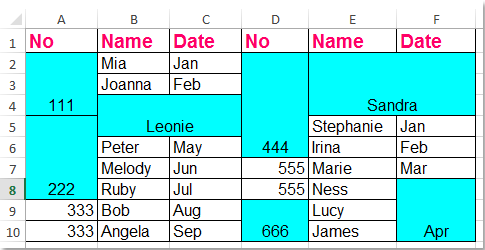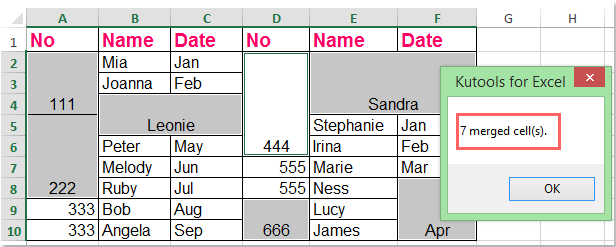Excelですべての結合セルを特定して選択するにはどうすればよいですか?
Excelで結合されたすべてのセルを見つけて選択する方法はご存知ですか? ここでは、Excelの選択範囲またはデータ範囲ですべての結合セルを迅速に特定して選択するための3つの便利な方法をご紹介します。

「検索」コマンドを使用してすべての結合セルを特定して選択する
「検索」コマンドを使用してすべての結合セルを特定して選択する
次の手順で、「検索」コマンドを使用してアクティブなワークシート内のすべての結合セルを特定して選択できます:
1. [ホーム] > [検索と選択] > [検索] をクリックして、「検索と置換」ダイアログボックスを開きます。Ctrl + F キーを押すことで「検索と置換」ダイアログボックスを開くこともできます。
2. ダイアログボックス内の [書式] ボタンをクリックします。(書式ボタンが見つからない場合は、[オプション] ボタンをクリックしてダイアログを展開してください。)スクリーンショットをご覧ください:

3. 表示される「検索の書式設定」ダイアログボックスで、配置タブのテキスト制御セクションにある [セルを結合] のみをチェックし、[OK] をクリックします。

4. これで「 検索と置換」ダイアログボックスに戻ります。「すべて検索」ボタンをクリックすると、すべての結合セルがこのダイアログボックスの下部にリストされます。Shiftキーを押しながらすべての検索結果を選択します。
すべての検索結果を選択すると、アクティブなシート内のすべての結合セルが選択されます。スクリーンショットをご覧ください:

ヒント: 選択範囲内の結合セルのみを特定、検索、選択したい場合は、まず範囲を選択する必要があります。
Kutools for Excelを使用してすべての結合セルを選択してカウントする
Kutools for Excelの「結合セルを選択」ツールを使用すると、1回のクリックですべての結合セルを特定、検索、選択することができます。
Kutools for Excelをインストール後、以下の手順を行ってください。( 今すぐ Kutools for Excel を無料ダウンロード! )
1. 結合セルを選択したいデータ範囲を選択します。
2. [Kutools] > [選択] > [結合セルを選択] をクリックします。スクリーンショットをご覧ください:

3. これで選択範囲内のすべての結合セルが一度に選択され、結合セルの数もカウントされます。スクリーンショットをご覧ください:
VBAコードを使用してすべての結合セルを特定する
VBA 1: すべての結合セルを特定してハイライトする
1. ALT + F11 キーを押すと、Microsoft Visual Basic for Applications ウィンドウが開きます。
2. 挿入 > モジュール をクリックし、表示されるモジュールウィンドウに次のマクロを貼り付けます。
Sub FindMergedcells()
'updateby Extendoffice
Dim x As Range
For Each x In ActiveSheet.UsedRange
If x.MergeCells Then
x.Interior.ColorIndex = 8
End If
Next
End Sub
3. F5 キーを押してこのマクロを実行します。アクティブなワークシート内のすべての結合セルが特定され、ハイライトされます。スクリーンショットをご覧ください:

VBA 2: すべての結合セルを特定してリスト化する
1. ALT + F11 キーを押すと、Microsoft Visual Basic for Applications ウィンドウが開きます。
2. [挿入] > [モジュール] をクリックし、表示されるモジュールウィンドウに次のマクロを貼り付けます。
Sub ListMergedcells()
'updateby Extendoffice
Dim x As Range
Dim sMsg As String
sMsg = ""
For Each x In ActiveSheet.UsedRange
If x.MergeCells Then
If sMsg = "" Then
sMsg = "Merged cells:" & vbCr
End If
sMsg = sMsg & Replace(x.Address, "$", "") & vbCr
End If
Next
If sMsg = "" Then
sMsg = "No merged cells."
End If
MsgBox sMsg
End Sub
3. F5 キーを押してこのマクロを実行すると、すべての結合セルがポップアップダイアログボックスにリストされます。スクリーンショットをご覧ください:

関連記事
Excelで保護されたワークシート内でセルを結合できるようにするにはどうすればよいですか?
デフォルトでは、保護されたワークシートではユーザーがセルを結合することはできません。ただし、本記事で提供しているVBAメソッドを使用することで、保護されたワークシート内でもセルを結合できます。
Excelでテーブルとして書式設定された範囲内のセルを結合するにはどうすればよいですか?
Excelでは、以下のようなスクリーンショットに示すように、いくつかの連続したセルを簡単に1つに結合するために「中央揃えで結合」機能を使用できます。しかし、Excelでテーブルとして書式設定された範囲内のセルを結合することはできません。これを処理するためのトリックはありますか?
Excelでセルを結合しても内容を中央揃えしない方法は?
Excelで2つ以上のセルを結合する場合、「中央揃えで結合」機能が役立ちます。しかし、時には、以下のようなスクリーンショットに示すように、セルを結合するだけで内容を中央揃えしないようにしたい場合があります。このチュートリアルでは、Excelでのこの作業を解決するための方法を紹介します。
Excelでセルを分割して重複する値で埋めるにはどうすればよいですか?
多数の結合セルを含むワークシートがあり、それらを解除して、元の結合セルから自動的に値を下方向にコピーする必要がある場合、どのように迅速に対処すればよいでしょうか?
最高のオフィス業務効率化ツール
| 🤖 | Kutools AI Aide:データ分析を革新します。主な機能:Intelligent Execution|コード生成|カスタム数式の作成|データの分析とグラフの生成|Kutools Functionsの呼び出し…… |
| 人気の機能:重複の検索・ハイライト・重複をマーキング|空白行を削除|データを失わずに列またはセルを統合|丸める…… | |
| スーパーLOOKUP:複数条件でのVLookup|複数値でのVLookup|複数シートの検索|ファジーマッチ…… | |
| 高度なドロップダウンリスト:ドロップダウンリストを素早く作成|連動ドロップダウンリスト|複数選択ドロップダウンリスト…… | |
| 列マネージャー:指定した数の列を追加 |列の移動 |非表示列の表示/非表示の切替| 範囲&列の比較…… | |
| 注目の機能:グリッドフォーカス|デザインビュー|強化された数式バー|ワークブック&ワークシートの管理|オートテキスト ライブラリ|日付ピッカー|データの統合 |セルの暗号化/復号化|リストで電子メールを送信|スーパーフィルター|特殊フィルタ(太字/斜体/取り消し線などをフィルター)…… | |
| トップ15ツールセット:12 種類のテキストツール(テキストの追加、特定の文字を削除など)|50種類以上のグラフ(ガントチャートなど)|40種類以上の便利な数式(誕生日に基づいて年齢を計算するなど)|19 種類の挿入ツール(QRコードの挿入、パスから画像の挿入など)|12 種類の変換ツール(単語に変換する、通貨変換など)|7種の統合&分割ツール(高度な行のマージ、セルの分割など)|… その他多数 |
Kutools for ExcelでExcelスキルを強化し、これまでにない効率を体感しましょう。 Kutools for Excelは300以上の高度な機能で生産性向上と保存時間を実現します。最も必要な機能はこちらをクリック...
Office TabでOfficeにタブインターフェースを追加し、作業をもっと簡単に
- Word、Excel、PowerPointでタブによる編集・閲覧を実現。
- 新しいウィンドウを開かず、同じウィンドウの新しいタブで複数のドキュメントを開いたり作成できます。
- 生産性が50%向上し、毎日のマウスクリック数を何百回も削減!
全てのKutoolsアドインを一つのインストーラーで
Kutools for Officeスイートは、Excel、Word、Outlook、PowerPoint用アドインとOffice Tab Proをまとめて提供。Officeアプリを横断して働くチームに最適です。
- オールインワンスイート — Excel、Word、Outlook、PowerPoint用アドインとOffice Tab Proが含まれます
- 1つのインストーラー・1つのライセンス —— 数分でセットアップ完了(MSI対応)
- 一括管理でより効率的 —— Officeアプリ間で快適な生産性を発揮
- 30日間フル機能お試し —— 登録やクレジットカード不要
- コストパフォーマンス最適 —— 個別購入よりお得
